Companies and Partnership Law: Legal and Ethical Considerations Report
VerifiedAdded on 2020/03/01
|7
|1914
|466
Report
AI Summary
This report provides a detailed analysis of companies and partnership law, focusing on the legal and ethical considerations of business formation and operation. The report begins by defining partnerships under the Partnership Act 1963, outlining the formation, liabilities, and dissolution of partnerships. It then examines company law, including the process of business registration, the role of the Australian Securities and Investments Commission (ASIC), and the implications of using a business name. The report further explores the legal and ethical challenges faced by a sole trader, including the misuse of client information and the concept of the corporate veil. It analyzes a case study involving a sole trader and their actions, discussing the legal consequences of misconduct and breaches of business ethics, particularly in relation to the use of client contacts from a previous employer. The report concludes by examining the role of ASIC in investigating and addressing misconduct, including fraud prevention and consumer protection. The analysis draws on relevant case law and legal principles to provide a comprehensive understanding of the subject matter.
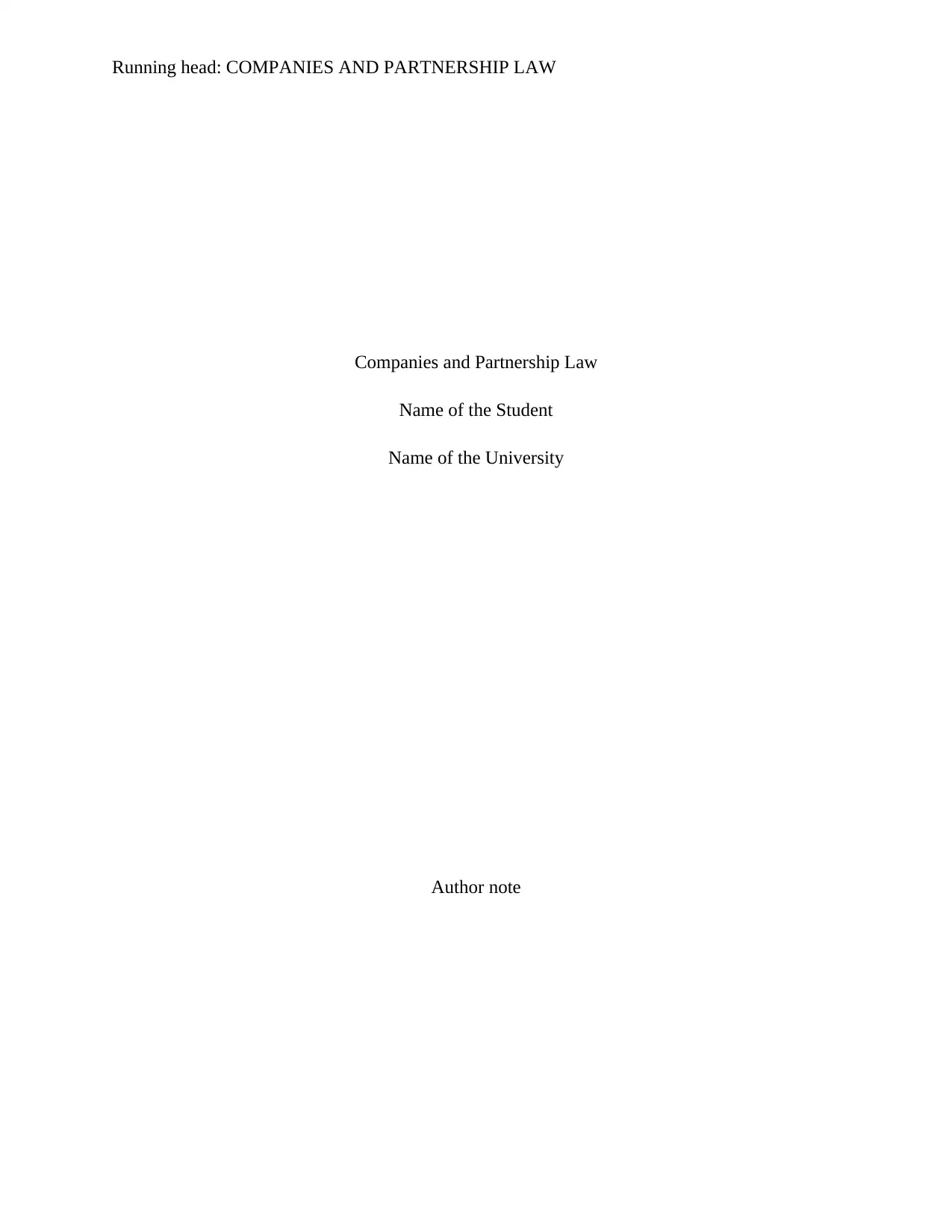
Running head: COMPANIES AND PARTNERSHIP LAW
Companies and Partnership Law
Name of the Student
Name of the University
Author note
Companies and Partnership Law
Name of the Student
Name of the University
Author note
Paraphrase This Document
Need a fresh take? Get an instant paraphrase of this document with our AI Paraphraser
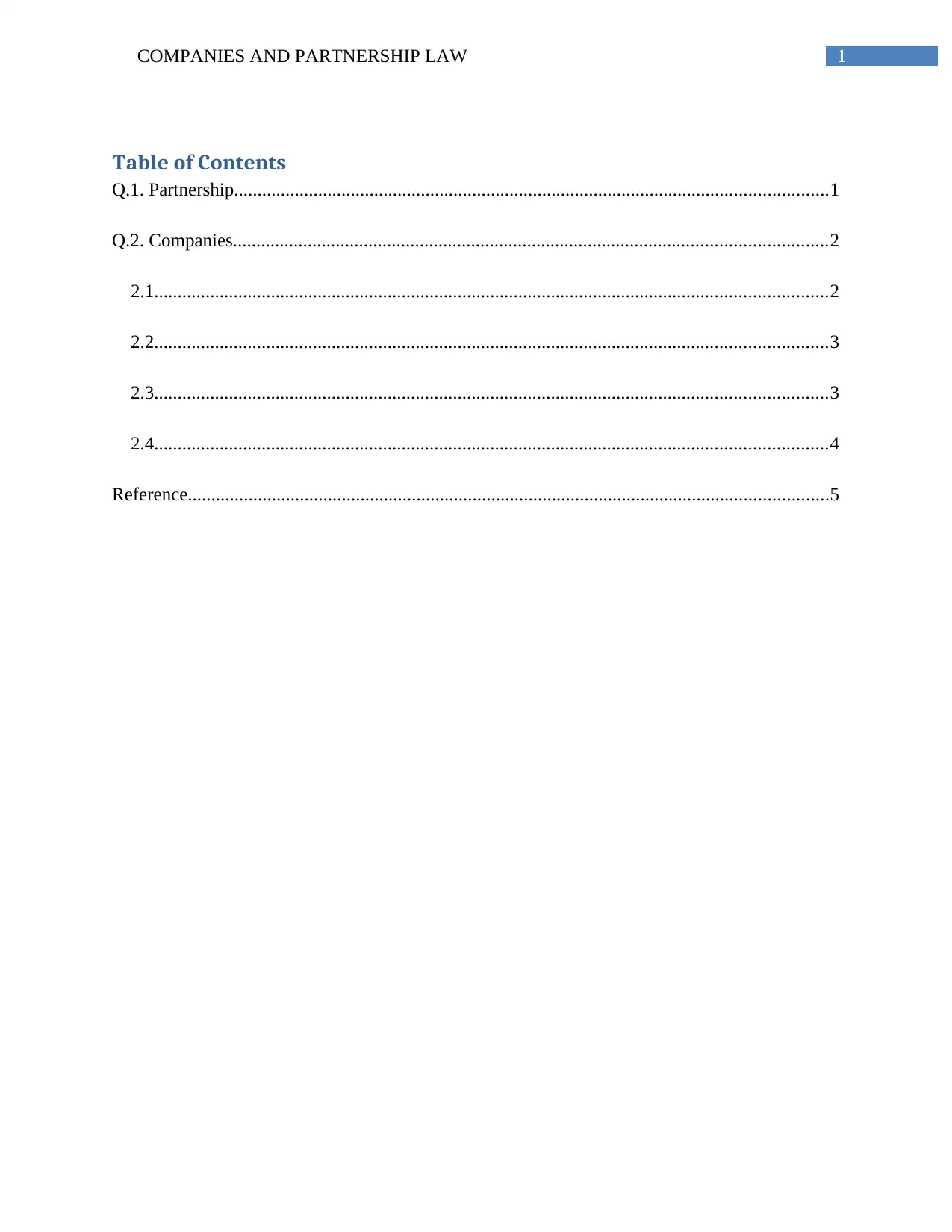
1COMPANIES AND PARTNERSHIP LAW
Table of Contents
Q.1. Partnership...............................................................................................................................1
Q.2. Companies...............................................................................................................................2
2.1................................................................................................................................................2
2.2................................................................................................................................................3
2.3................................................................................................................................................3
2.4................................................................................................................................................4
Reference.........................................................................................................................................5
Table of Contents
Q.1. Partnership...............................................................................................................................1
Q.2. Companies...............................................................................................................................2
2.1................................................................................................................................................2
2.2................................................................................................................................................3
2.3................................................................................................................................................3
2.4................................................................................................................................................4
Reference.........................................................................................................................................5
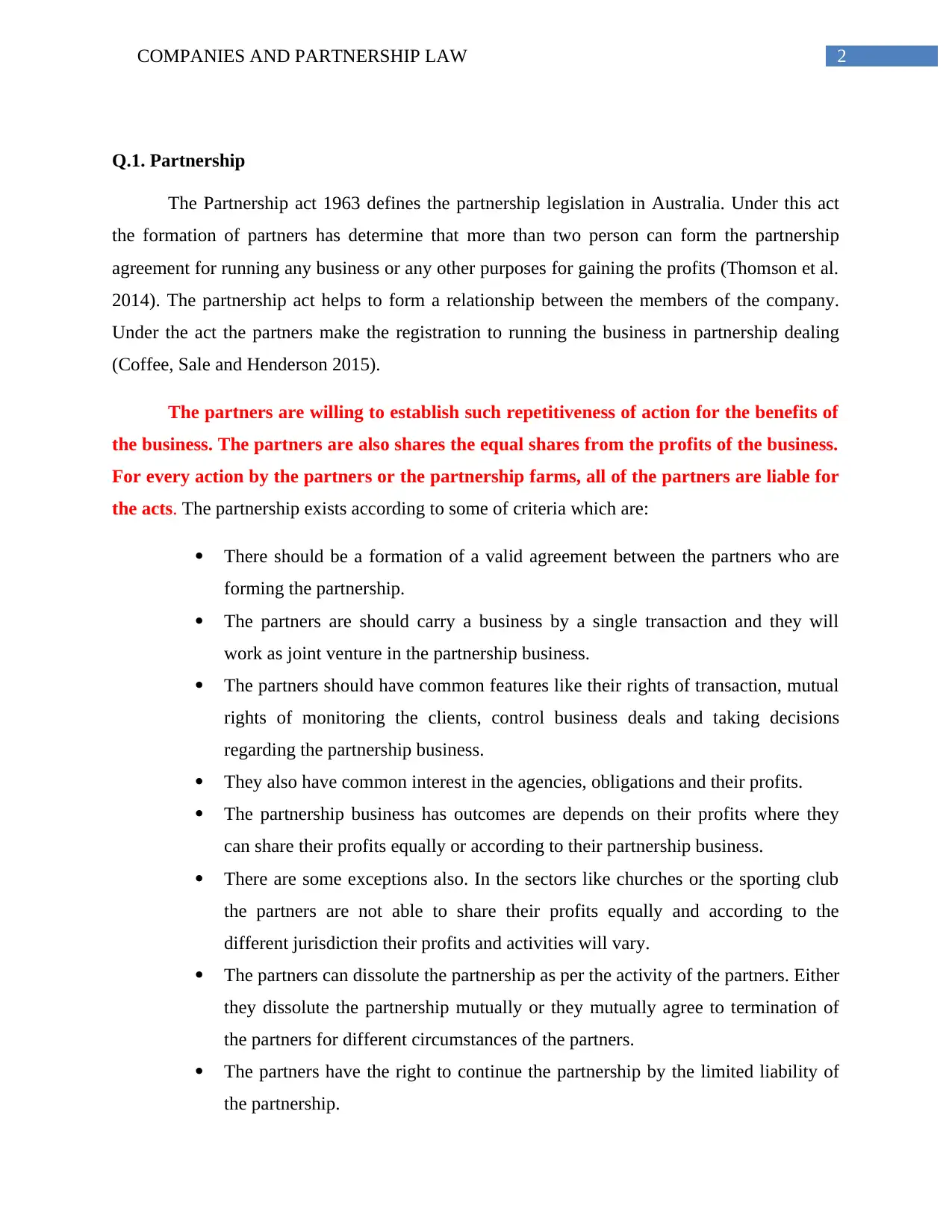
2COMPANIES AND PARTNERSHIP LAW
Q.1. Partnership
The Partnership act 1963 defines the partnership legislation in Australia. Under this act
the formation of partners has determine that more than two person can form the partnership
agreement for running any business or any other purposes for gaining the profits (Thomson et al.
2014). The partnership act helps to form a relationship between the members of the company.
Under the act the partners make the registration to running the business in partnership dealing
(Coffee, Sale and Henderson 2015).
The partners are willing to establish such repetitiveness of action for the benefits of
the business. The partners are also shares the equal shares from the profits of the business.
For every action by the partners or the partnership farms, all of the partners are liable for
the acts. The partnership exists according to some of criteria which are:
There should be a formation of a valid agreement between the partners who are
forming the partnership.
The partners are should carry a business by a single transaction and they will
work as joint venture in the partnership business.
The partners should have common features like their rights of transaction, mutual
rights of monitoring the clients, control business deals and taking decisions
regarding the partnership business.
They also have common interest in the agencies, obligations and their profits.
The partnership business has outcomes are depends on their profits where they
can share their profits equally or according to their partnership business.
There are some exceptions also. In the sectors like churches or the sporting club
the partners are not able to share their profits equally and according to the
different jurisdiction their profits and activities will vary.
The partners can dissolute the partnership as per the activity of the partners. Either
they dissolute the partnership mutually or they mutually agree to termination of
the partners for different circumstances of the partners.
The partners have the right to continue the partnership by the limited liability of
the partnership.
Q.1. Partnership
The Partnership act 1963 defines the partnership legislation in Australia. Under this act
the formation of partners has determine that more than two person can form the partnership
agreement for running any business or any other purposes for gaining the profits (Thomson et al.
2014). The partnership act helps to form a relationship between the members of the company.
Under the act the partners make the registration to running the business in partnership dealing
(Coffee, Sale and Henderson 2015).
The partners are willing to establish such repetitiveness of action for the benefits of
the business. The partners are also shares the equal shares from the profits of the business.
For every action by the partners or the partnership farms, all of the partners are liable for
the acts. The partnership exists according to some of criteria which are:
There should be a formation of a valid agreement between the partners who are
forming the partnership.
The partners are should carry a business by a single transaction and they will
work as joint venture in the partnership business.
The partners should have common features like their rights of transaction, mutual
rights of monitoring the clients, control business deals and taking decisions
regarding the partnership business.
They also have common interest in the agencies, obligations and their profits.
The partnership business has outcomes are depends on their profits where they
can share their profits equally or according to their partnership business.
There are some exceptions also. In the sectors like churches or the sporting club
the partners are not able to share their profits equally and according to the
different jurisdiction their profits and activities will vary.
The partners can dissolute the partnership as per the activity of the partners. Either
they dissolute the partnership mutually or they mutually agree to termination of
the partners for different circumstances of the partners.
The partners have the right to continue the partnership by the limited liability of
the partnership.
⊘ This is a preview!⊘
Do you want full access?
Subscribe today to unlock all pages.

Trusted by 1+ million students worldwide
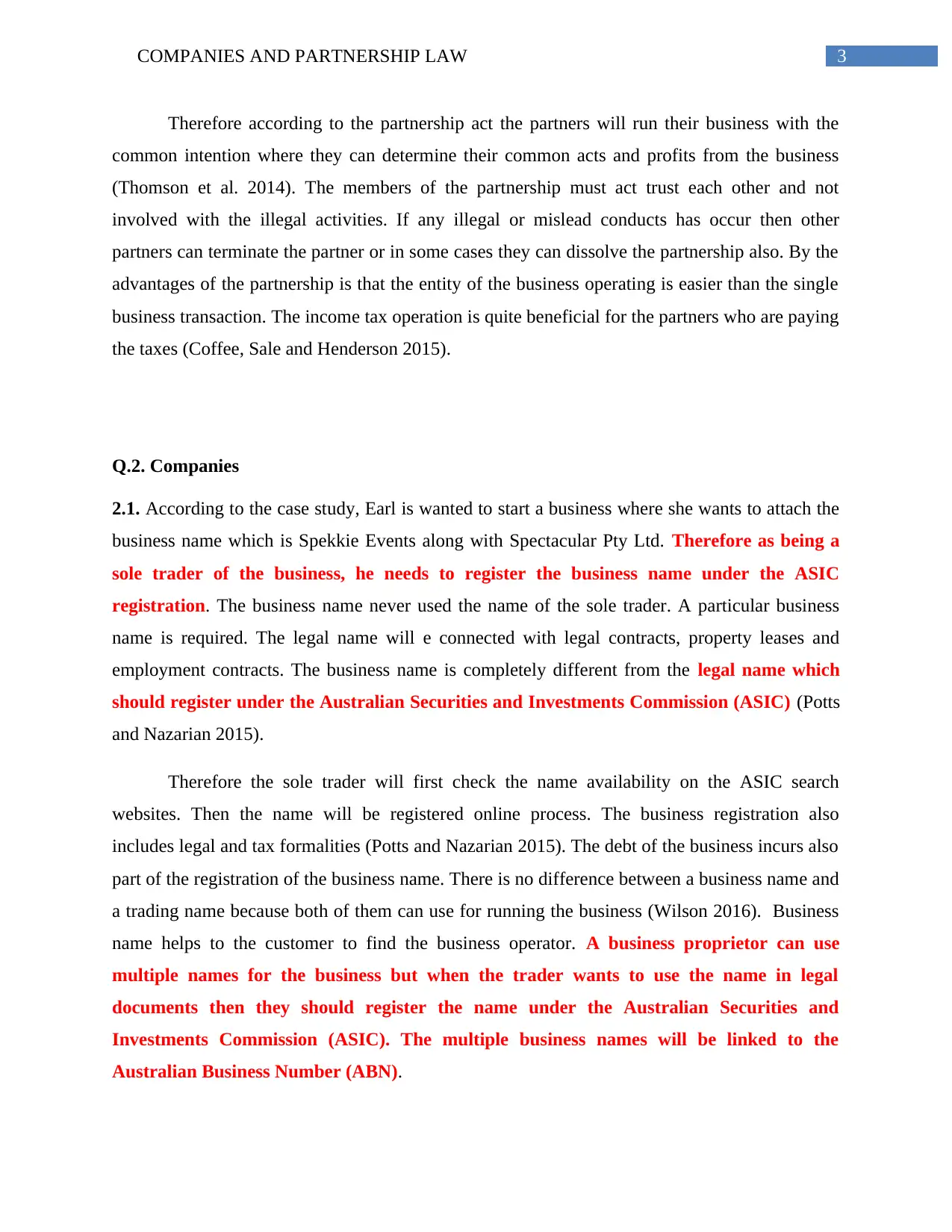
3COMPANIES AND PARTNERSHIP LAW
Therefore according to the partnership act the partners will run their business with the
common intention where they can determine their common acts and profits from the business
(Thomson et al. 2014). The members of the partnership must act trust each other and not
involved with the illegal activities. If any illegal or mislead conducts has occur then other
partners can terminate the partner or in some cases they can dissolve the partnership also. By the
advantages of the partnership is that the entity of the business operating is easier than the single
business transaction. The income tax operation is quite beneficial for the partners who are paying
the taxes (Coffee, Sale and Henderson 2015).
Q.2. Companies
2.1. According to the case study, Earl is wanted to start a business where she wants to attach the
business name which is Spekkie Events along with Spectacular Pty Ltd. Therefore as being a
sole trader of the business, he needs to register the business name under the ASIC
registration. The business name never used the name of the sole trader. A particular business
name is required. The legal name will e connected with legal contracts, property leases and
employment contracts. The business name is completely different from the legal name which
should register under the Australian Securities and Investments Commission (ASIC) (Potts
and Nazarian 2015).
Therefore the sole trader will first check the name availability on the ASIC search
websites. Then the name will be registered online process. The business registration also
includes legal and tax formalities (Potts and Nazarian 2015). The debt of the business incurs also
part of the registration of the business name. There is no difference between a business name and
a trading name because both of them can use for running the business (Wilson 2016). Business
name helps to the customer to find the business operator. A business proprietor can use
multiple names for the business but when the trader wants to use the name in legal
documents then they should register the name under the Australian Securities and
Investments Commission (ASIC). The multiple business names will be linked to the
Australian Business Number (ABN).
Therefore according to the partnership act the partners will run their business with the
common intention where they can determine their common acts and profits from the business
(Thomson et al. 2014). The members of the partnership must act trust each other and not
involved with the illegal activities. If any illegal or mislead conducts has occur then other
partners can terminate the partner or in some cases they can dissolve the partnership also. By the
advantages of the partnership is that the entity of the business operating is easier than the single
business transaction. The income tax operation is quite beneficial for the partners who are paying
the taxes (Coffee, Sale and Henderson 2015).
Q.2. Companies
2.1. According to the case study, Earl is wanted to start a business where she wants to attach the
business name which is Spekkie Events along with Spectacular Pty Ltd. Therefore as being a
sole trader of the business, he needs to register the business name under the ASIC
registration. The business name never used the name of the sole trader. A particular business
name is required. The legal name will e connected with legal contracts, property leases and
employment contracts. The business name is completely different from the legal name which
should register under the Australian Securities and Investments Commission (ASIC) (Potts
and Nazarian 2015).
Therefore the sole trader will first check the name availability on the ASIC search
websites. Then the name will be registered online process. The business registration also
includes legal and tax formalities (Potts and Nazarian 2015). The debt of the business incurs also
part of the registration of the business name. There is no difference between a business name and
a trading name because both of them can use for running the business (Wilson 2016). Business
name helps to the customer to find the business operator. A business proprietor can use
multiple names for the business but when the trader wants to use the name in legal
documents then they should register the name under the Australian Securities and
Investments Commission (ASIC). The multiple business names will be linked to the
Australian Business Number (ABN).
Paraphrase This Document
Need a fresh take? Get an instant paraphrase of this document with our AI Paraphraser
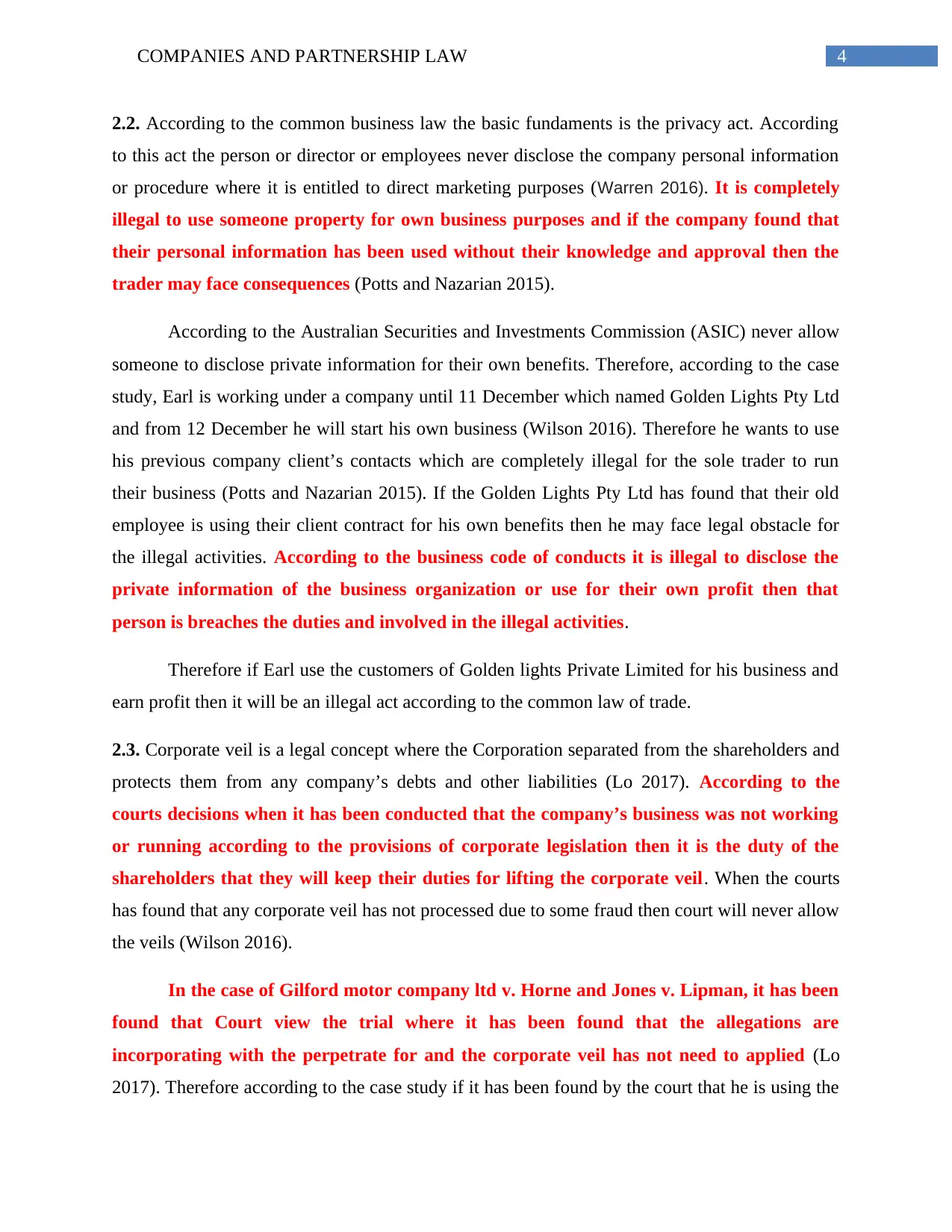
4COMPANIES AND PARTNERSHIP LAW
2.2. According to the common business law the basic fundaments is the privacy act. According
to this act the person or director or employees never disclose the company personal information
or procedure where it is entitled to direct marketing purposes (Warren 2016). It is completely
illegal to use someone property for own business purposes and if the company found that
their personal information has been used without their knowledge and approval then the
trader may face consequences (Potts and Nazarian 2015).
According to the Australian Securities and Investments Commission (ASIC) never allow
someone to disclose private information for their own benefits. Therefore, according to the case
study, Earl is working under a company until 11 December which named Golden Lights Pty Ltd
and from 12 December he will start his own business (Wilson 2016). Therefore he wants to use
his previous company client’s contacts which are completely illegal for the sole trader to run
their business (Potts and Nazarian 2015). If the Golden Lights Pty Ltd has found that their old
employee is using their client contract for his own benefits then he may face legal obstacle for
the illegal activities. According to the business code of conducts it is illegal to disclose the
private information of the business organization or use for their own profit then that
person is breaches the duties and involved in the illegal activities.
Therefore if Earl use the customers of Golden lights Private Limited for his business and
earn profit then it will be an illegal act according to the common law of trade.
2.3. Corporate veil is a legal concept where the Corporation separated from the shareholders and
protects them from any company’s debts and other liabilities (Lo 2017). According to the
courts decisions when it has been conducted that the company’s business was not working
or running according to the provisions of corporate legislation then it is the duty of the
shareholders that they will keep their duties for lifting the corporate veil. When the courts
has found that any corporate veil has not processed due to some fraud then court will never allow
the veils (Wilson 2016).
In the case of Gilford motor company ltd v. Horne and Jones v. Lipman, it has been
found that Court view the trial where it has been found that the allegations are
incorporating with the perpetrate for and the corporate veil has not need to applied (Lo
2017). Therefore according to the case study if it has been found by the court that he is using the
2.2. According to the common business law the basic fundaments is the privacy act. According
to this act the person or director or employees never disclose the company personal information
or procedure where it is entitled to direct marketing purposes (Warren 2016). It is completely
illegal to use someone property for own business purposes and if the company found that
their personal information has been used without their knowledge and approval then the
trader may face consequences (Potts and Nazarian 2015).
According to the Australian Securities and Investments Commission (ASIC) never allow
someone to disclose private information for their own benefits. Therefore, according to the case
study, Earl is working under a company until 11 December which named Golden Lights Pty Ltd
and from 12 December he will start his own business (Wilson 2016). Therefore he wants to use
his previous company client’s contacts which are completely illegal for the sole trader to run
their business (Potts and Nazarian 2015). If the Golden Lights Pty Ltd has found that their old
employee is using their client contract for his own benefits then he may face legal obstacle for
the illegal activities. According to the business code of conducts it is illegal to disclose the
private information of the business organization or use for their own profit then that
person is breaches the duties and involved in the illegal activities.
Therefore if Earl use the customers of Golden lights Private Limited for his business and
earn profit then it will be an illegal act according to the common law of trade.
2.3. Corporate veil is a legal concept where the Corporation separated from the shareholders and
protects them from any company’s debts and other liabilities (Lo 2017). According to the
courts decisions when it has been conducted that the company’s business was not working
or running according to the provisions of corporate legislation then it is the duty of the
shareholders that they will keep their duties for lifting the corporate veil. When the courts
has found that any corporate veil has not processed due to some fraud then court will never allow
the veils (Wilson 2016).
In the case of Gilford motor company ltd v. Horne and Jones v. Lipman, it has been
found that Court view the trial where it has been found that the allegations are
incorporating with the perpetrate for and the corporate veil has not need to applied (Lo
2017). Therefore according to the case study if it has been found by the court that he is using the
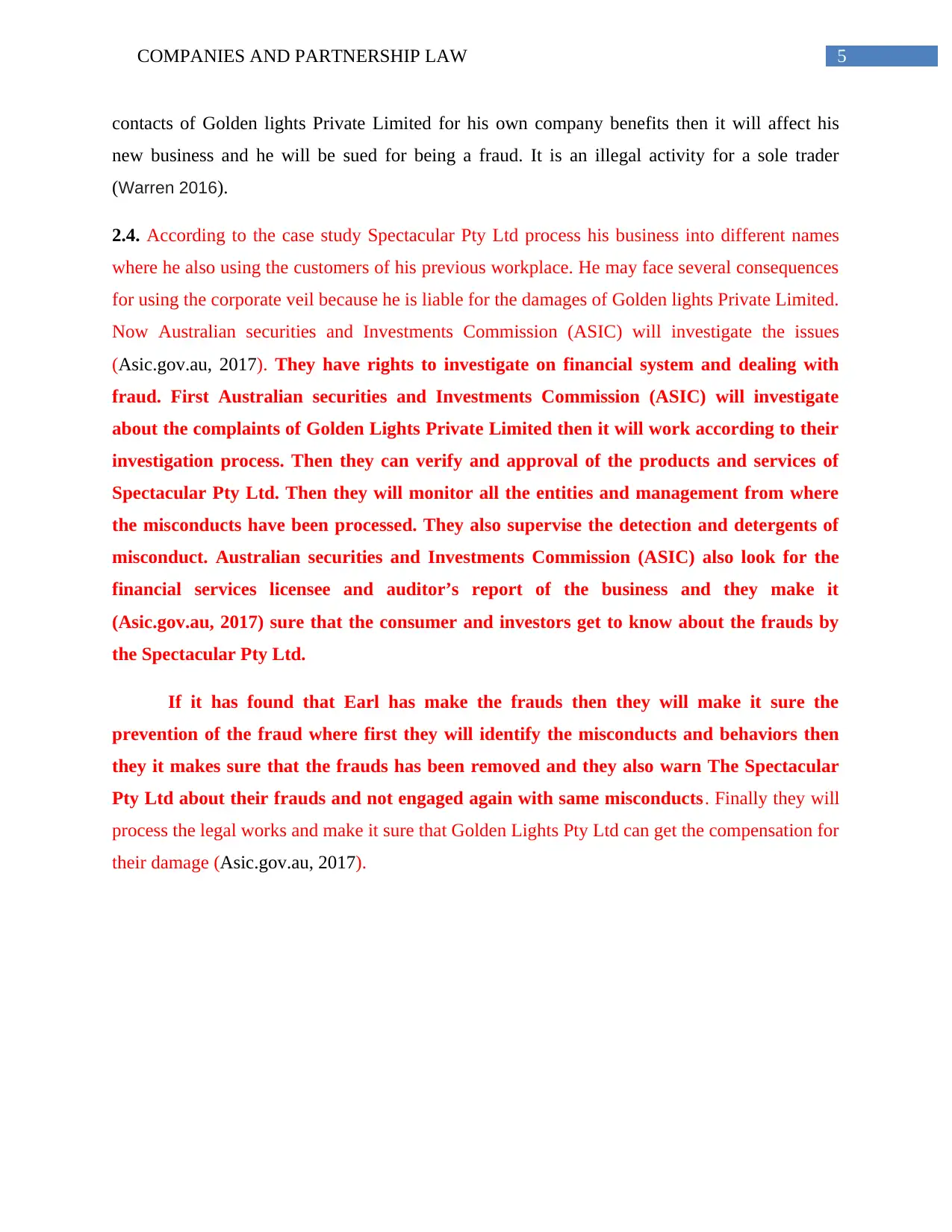
5COMPANIES AND PARTNERSHIP LAW
contacts of Golden lights Private Limited for his own company benefits then it will affect his
new business and he will be sued for being a fraud. It is an illegal activity for a sole trader
(Warren 2016).
2.4. According to the case study Spectacular Pty Ltd process his business into different names
where he also using the customers of his previous workplace. He may face several consequences
for using the corporate veil because he is liable for the damages of Golden lights Private Limited.
Now Australian securities and Investments Commission (ASIC) will investigate the issues
(Asic.gov.au, 2017). They have rights to investigate on financial system and dealing with
fraud. First Australian securities and Investments Commission (ASIC) will investigate
about the complaints of Golden Lights Private Limited then it will work according to their
investigation process. Then they can verify and approval of the products and services of
Spectacular Pty Ltd. Then they will monitor all the entities and management from where
the misconducts have been processed. They also supervise the detection and detergents of
misconduct. Australian securities and Investments Commission (ASIC) also look for the
financial services licensee and auditor’s report of the business and they make it
(Asic.gov.au, 2017) sure that the consumer and investors get to know about the frauds by
the Spectacular Pty Ltd.
If it has found that Earl has make the frauds then they will make it sure the
prevention of the fraud where first they will identify the misconducts and behaviors then
they it makes sure that the frauds has been removed and they also warn The Spectacular
Pty Ltd about their frauds and not engaged again with same misconducts. Finally they will
process the legal works and make it sure that Golden Lights Pty Ltd can get the compensation for
their damage (Asic.gov.au, 2017).
contacts of Golden lights Private Limited for his own company benefits then it will affect his
new business and he will be sued for being a fraud. It is an illegal activity for a sole trader
(Warren 2016).
2.4. According to the case study Spectacular Pty Ltd process his business into different names
where he also using the customers of his previous workplace. He may face several consequences
for using the corporate veil because he is liable for the damages of Golden lights Private Limited.
Now Australian securities and Investments Commission (ASIC) will investigate the issues
(Asic.gov.au, 2017). They have rights to investigate on financial system and dealing with
fraud. First Australian securities and Investments Commission (ASIC) will investigate
about the complaints of Golden Lights Private Limited then it will work according to their
investigation process. Then they can verify and approval of the products and services of
Spectacular Pty Ltd. Then they will monitor all the entities and management from where
the misconducts have been processed. They also supervise the detection and detergents of
misconduct. Australian securities and Investments Commission (ASIC) also look for the
financial services licensee and auditor’s report of the business and they make it
(Asic.gov.au, 2017) sure that the consumer and investors get to know about the frauds by
the Spectacular Pty Ltd.
If it has found that Earl has make the frauds then they will make it sure the
prevention of the fraud where first they will identify the misconducts and behaviors then
they it makes sure that the frauds has been removed and they also warn The Spectacular
Pty Ltd about their frauds and not engaged again with same misconducts. Finally they will
process the legal works and make it sure that Golden Lights Pty Ltd can get the compensation for
their damage (Asic.gov.au, 2017).
⊘ This is a preview!⊘
Do you want full access?
Subscribe today to unlock all pages.

Trusted by 1+ million students worldwide
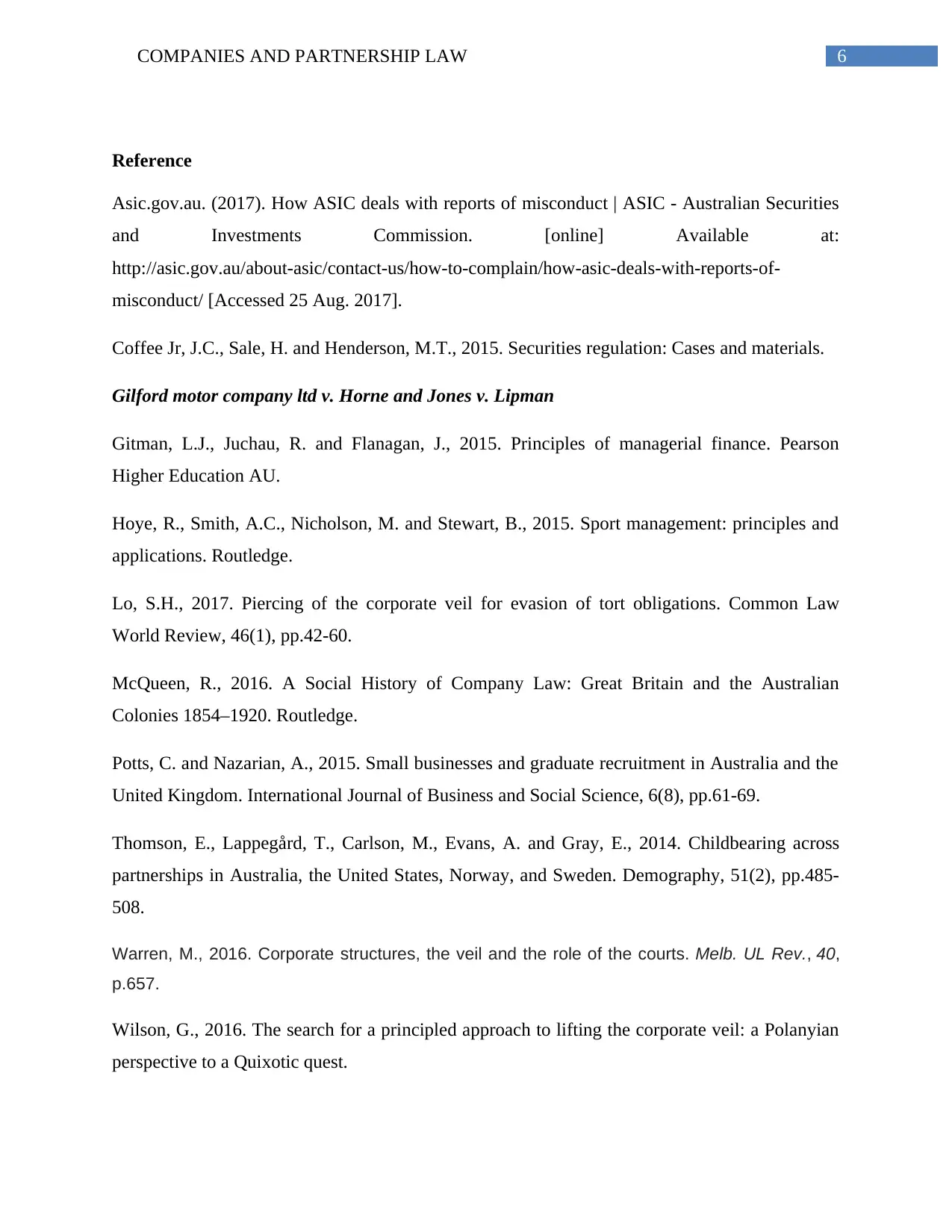
6COMPANIES AND PARTNERSHIP LAW
Reference
Asic.gov.au. (2017). How ASIC deals with reports of misconduct | ASIC - Australian Securities
and Investments Commission. [online] Available at:
http://asic.gov.au/about-asic/contact-us/how-to-complain/how-asic-deals-with-reports-of-
misconduct/ [Accessed 25 Aug. 2017].
Coffee Jr, J.C., Sale, H. and Henderson, M.T., 2015. Securities regulation: Cases and materials.
Gilford motor company ltd v. Horne and Jones v. Lipman
Gitman, L.J., Juchau, R. and Flanagan, J., 2015. Principles of managerial finance. Pearson
Higher Education AU.
Hoye, R., Smith, A.C., Nicholson, M. and Stewart, B., 2015. Sport management: principles and
applications. Routledge.
Lo, S.H., 2017. Piercing of the corporate veil for evasion of tort obligations. Common Law
World Review, 46(1), pp.42-60.
McQueen, R., 2016. A Social History of Company Law: Great Britain and the Australian
Colonies 1854–1920. Routledge.
Potts, C. and Nazarian, A., 2015. Small businesses and graduate recruitment in Australia and the
United Kingdom. International Journal of Business and Social Science, 6(8), pp.61-69.
Thomson, E., Lappegård, T., Carlson, M., Evans, A. and Gray, E., 2014. Childbearing across
partnerships in Australia, the United States, Norway, and Sweden. Demography, 51(2), pp.485-
508.
Warren, M., 2016. Corporate structures, the veil and the role of the courts. Melb. UL Rev., 40,
p.657.
Wilson, G., 2016. The search for a principled approach to lifting the corporate veil: a Polanyian
perspective to a Quixotic quest.
Reference
Asic.gov.au. (2017). How ASIC deals with reports of misconduct | ASIC - Australian Securities
and Investments Commission. [online] Available at:
http://asic.gov.au/about-asic/contact-us/how-to-complain/how-asic-deals-with-reports-of-
misconduct/ [Accessed 25 Aug. 2017].
Coffee Jr, J.C., Sale, H. and Henderson, M.T., 2015. Securities regulation: Cases and materials.
Gilford motor company ltd v. Horne and Jones v. Lipman
Gitman, L.J., Juchau, R. and Flanagan, J., 2015. Principles of managerial finance. Pearson
Higher Education AU.
Hoye, R., Smith, A.C., Nicholson, M. and Stewart, B., 2015. Sport management: principles and
applications. Routledge.
Lo, S.H., 2017. Piercing of the corporate veil for evasion of tort obligations. Common Law
World Review, 46(1), pp.42-60.
McQueen, R., 2016. A Social History of Company Law: Great Britain and the Australian
Colonies 1854–1920. Routledge.
Potts, C. and Nazarian, A., 2015. Small businesses and graduate recruitment in Australia and the
United Kingdom. International Journal of Business and Social Science, 6(8), pp.61-69.
Thomson, E., Lappegård, T., Carlson, M., Evans, A. and Gray, E., 2014. Childbearing across
partnerships in Australia, the United States, Norway, and Sweden. Demography, 51(2), pp.485-
508.
Warren, M., 2016. Corporate structures, the veil and the role of the courts. Melb. UL Rev., 40,
p.657.
Wilson, G., 2016. The search for a principled approach to lifting the corporate veil: a Polanyian
perspective to a Quixotic quest.
1 out of 7
Related Documents
Your All-in-One AI-Powered Toolkit for Academic Success.
+13062052269
info@desklib.com
Available 24*7 on WhatsApp / Email
![[object Object]](/_next/static/media/star-bottom.7253800d.svg)
Unlock your academic potential
Copyright © 2020–2025 A2Z Services. All Rights Reserved. Developed and managed by ZUCOL.





